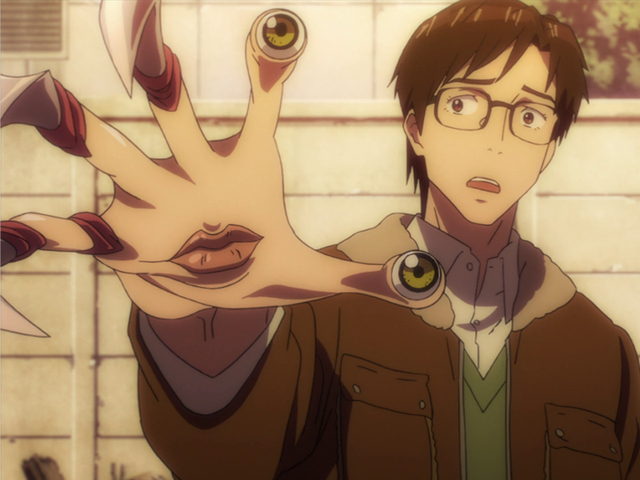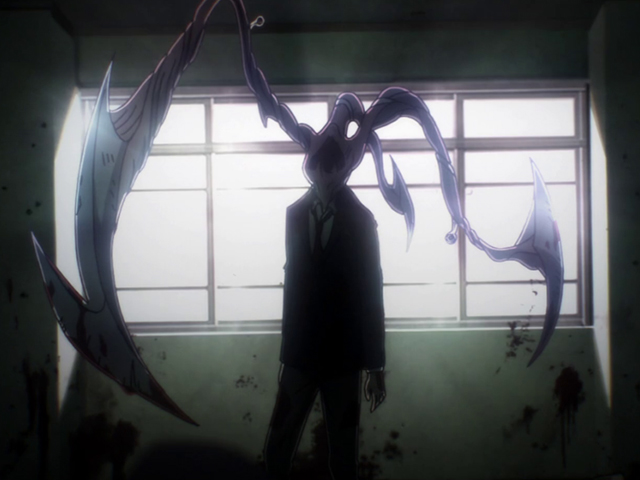Filtered By: Scitech
SciTech
Anime Review: A teenage boy and his right hand in ‘Parasyte: The Maxim’

Horror takes many forms, from a visceral disgust for the grotesque to the creeping dread engendered by uncertainty. “Parasyte: The Maxim,” or “Kiseijuu: Sei no Kakuritsu,” has plenty of both.
But “Parasyte” also avoids the usual schlock by exploring themes that should resonate with anyone who has ever questioned what it means to be human. And while comparisons to horror classics “Invasion of the Body Snatchers” and “The Thing” are inevitable, “Parasyte” comes into its own thanks to a story that encourages us to rethink aspects of our existence that we’ve taken for granted.
Teenage nightmare
Awkward around girls and terrified of bugs, Shinichi Izumi is as average as a high school student can get. One night, he is attacked by a tiny, slug-like organism. It burrows into his hand and crawls up his arm, but thanks to quick thinking, he manages to arrest its progress.
The next day, a strange, shapeshifting creature introduces itself to Shinichi. But there is nothing joyous about the occasion; ensuring the teenager will never enjoy a single private moment in his life, the creature has transformed itself into Shinichi’s right hand.
Shinichi and his sentient hand – who names itself Migi – soon discover that there are others like them in Japan . Unlike them, these Parasites know only one thing: to gorge themselves on a steady diet of human flesh.
As the Parasites grow bolder and the body count skyrockets, Shinichi and Migi realize that, to survive, they have to learn to coexist despite their differences. In other words: adapt, or die.

Coming of age
“Parasyte” narrates Shinichi’s transition into adulthood amidst the escalating horrors of a gruesome alien infestation. Every Parasite is driven to select a host, kill them, take over their body, and assume their appearance. The resulting imitation is indistinguishable from the original human, with only the emptiness in their eyes providing any hint of their true nature.
The inaugural episodes can get rather exposition-heavy when explaining these concepts. But it is also this unhurried pace and attention to detail, which pervades all 24 episodes, that is the anime’s greatest strength. Not only do the aliens become more terrifying as we learn about them, we also come to know the main characters more intimately.
“Parasyte” excels when it comes to character development, particularly where Shinichi and Migi are concerned. The pair are polar opposites: Migi, whose priority is survival, is logical and unburdened by human emotions, whereas Shinichi is just an ordinary kid yearning for an ordinary life. Not friends but necessary allies, watching their relationship grow as they’re forced to evolve beyond their limitations is the highlight of the show.
The series also dwells on Shinichi’s relationships with those around him. Family dynamics are rarely explored in anime, but here we see the tenacious, unconditional bond between Shinichi and his parents. It’s a beautiful reminder of what home truly is. We also see his interactions with his friends, even witness a budding romance with a crush. It’s all extremely relatable, not to mention touching.
This is “Parasyte’s” masterful manipulation of our emotions at work. Because we grow to care about these characters, it’s all the more crushing when the unthinkable happens. It helps that most of the victims are good, normal people who haven’t done anything to deserve such extraordinary suffering. They could be our siblings, our friends, our lovers – and the idea that any of them could die so horribly at any moment will keep you biting those nails till you’ve worn them down to the quick.
In “Parasyte,” characters also grieve for lost loved ones, and in the process are transformed into shadows of themselves. It’s this realistic portrayal of death’s repercussions that twists the knife even deeper.
When it comes down to it, however, this story is all about Shinichi and Migi. Every character, tragedy, and plot contrivance is in service to their growth. The supporting characters are rarely used to their full potential. In fact, following the conclusion of certain arcs, some characters are relegated to the background, never to affect the story in any substantial way ever again. It seems wasteful, especially after showing us how interesting these characters are and still could be.

Tentacle action
As bleak as “Parayste” is, it’s got some pulse-pounding action. Parasites can morph into various bladed, tentacled shapes, so fighting one is never a straightforward affair. Shinichi and Migi often use mind games to avoid getting slaughtered, and watching them outmaneuver a more powerful foe is intensely satisfying.
These battle scenes sometimes cheat by using repeatedly looping animations. It’s no deal breaker, as the animation in general is good.
Many characters are oddly droopy-eyed, which may take some getting used to. Their faces, however, are wonderfully expressive, with numerous lines and contortions conveying every emotional nuance. Characters also look their age, which is incredible in an era when most anime have a tendency to make everybody appear sixteen.
Though “Parasyte” is violent, the gore is hardly gratuitous. Nevertheless, viewers with extremely weak stomachs are advised to keep a barf bag in proximity.

Human nature
When it’s not decapitating monsters or ripping out your heart with another character death, “Parasyte” busies itself posing questions to the viewer. It’s likely you’ve heard most of these before, but that the series brings them up goes to show how integral these considerations are in shaping the human experience.
They start off innocuously enough. Should Shinichi expose his freak hand to his friends and family? How would such a revelation affect his relationship with them? Would keeping things a secret destroy such ties?
As things get more complicated for our heroes, however, so do the questions. Shinichi is trapped in a situation that would drive anyone else to despair; to survive, one would have to transform into something more monster than human. How far would you go to save yourself? How much would you sacrifice for the good of the many?
Do emotions offer a survival benefit, or are they, as Migi suggests, a distraction from the important things? If all organisms have a “directive” that gives them purpose in life, what is the human directive?
We skew everything in favor of our species. We have exercised our ability to corrupt all that we touch. Seeing things in this perspective, can we honestly say we’ve earned the right to call ourselves the masters of this world?
When reality often forces us to live like beasts, what is it that makes us human?
Some of these are questions we’ve been asking ourselves for millennia. But like many effective works of fiction, “Parasyte” doesn’t spoon-feed us “absolute truths”; it is our responsibility as a species to figure out those answers for ourselves.
Evolution
No character, no matter how beloved or random, is ever safe in “Parasyte: The Maxim.” This unrelenting suspense is what makes it such a deliciously nerve-wracking experience.
But while its horror is disturbing and its action thrilling, “Parasyte” is also deeply self-reflective. Shinichi and Migi make wonderful leads, not only due to their excellent development, but also because their plight could be seen as an allegorical representation of the struggle for humanity that exists within all of us. We may all be mere organisms in the grand scheme of things, but it is, perhaps, in the great undertaking to transcend the limits of our nature that we evolve into something more. — TJD, GMA News
More Videos
Most Popular




